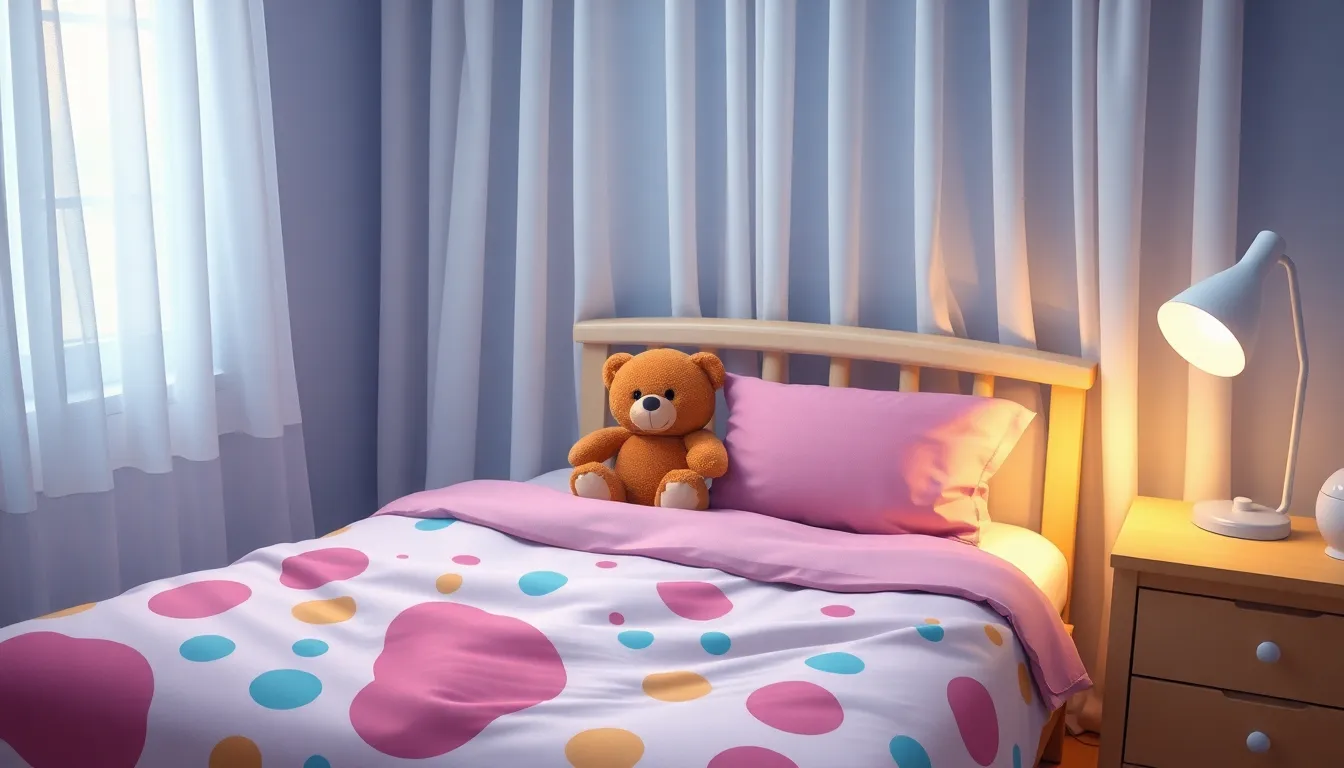Table of Contents
ToggleEvery parent knows that getting a toddler to bed can feel like an Olympic sport. With the energy of a thousand suns and the negotiation skills of a seasoned diplomat, little ones can turn bedtime into a hilarious challenge. But fear not! A well-structured bedtime routine can transform this nightly circus into a smooth, peaceful experience.
Importance Of A Toddler Bedtime Routine
Establishing a toddler bedtime routine significantly benefits both children and parents. Consistency promotes healthy sleep habits, allowing toddlers to understand when it’s time to wind down. A predictable sequence of activities, such as reading a story or brushing teeth, signals to a child that bedtime approaches.
Creating a calming atmosphere is essential for transition. Reducing screen time before bed decreases stimulation, allowing toddlers to relax more easily. Dimming the lights and playing soft music enhances a sense of security, making them feel more at ease.
Sleep studies indicate that children who follow consistent routines display fewer behavioral problems and improved emotional regulation. In fact, research reveals that toddlers with structured bedtime practices sleep better and wake up less frequently during the night. Parents often experience reduced anxiety when a clear routine is in place, which fosters a peaceful environment for both parties.
Additionally, a bedtime routine strengthens the parent-child bond. Engaging in special one-on-one time during these moments builds trust and intimacy. Simple rituals like a goodnight hug or a loving farewell can leave lasting impressions, reinforcing feelings of safety and affection.
A toddler bedtime routine not only helps in achieving better sleep patterns but also increases emotional well-being. Prioritizing this routine contributes to healthier family dynamics, ultimately transforming bedtime into a harmonious experience.
Key Elements Of An Effective Routine

Establishing an effective bedtime routine relies on key elements that foster relaxation and consistency. These elements work together to create a seamless transition from daytime activities to restful sleep.
Consistent Timing
Consistency in bedtime provides structure for toddlers. Going to bed at the same time each night helps regulate their internal clock. Research shows that predictable sleep schedules result in better sleep quality for children. Parents should aim for a bedtime that allows their toddler to receive the recommended 10 to 12 hours of sleep. Sticking to this schedule promotes a sense of security and makes bedtime less of a struggle.
Calming Activities
Incorporating calming activities into the bedtime routine makes a significant difference. Parents can find success in activities such as reading, singing lullabies, or engaging in gentle stretches. Each calming activity signals that it’s time to wind down, helping toddlers transition from active play to sleep. Limiting stimulating interactions like roughhousing or loud noises creates a peaceful atmosphere. As a result, toddlers may fall asleep more quickly and peacefully.
Environment Setup
Creating an inviting sleep environment shapes the bedtime experience. Parents should consider dimming lights and reducing noise to foster calmness. A comfortable mattress and soft bedding encourage relaxation, while a consistent sleep setting reinforces familiarity. Keeping the room cool, ideally between 68°F and 72°F, optimizes sleeping conditions. By prioritizing a well-set environment, parents enhance the likelihood of smooth, restful nights for their toddlers.
Tips For Creating A Successful Routine
A successful toddler bedtime routine relies on structure and an inviting environment. Engaging toddlers in the process enhances cooperation and enthusiasm.
Involving Your Toddler
Involving toddlers in their bedtime routine builds ownership and excitement. Allow children to choose their pajamas, creating a sense of autonomy. Encouraging them to select a book fosters participation, making storytime personal. Giving them simple tasks, like putting away toys, adds responsibility. Lastly, asking for their input on calming activities, like choosing a lullaby, deepens their connection to the routine.
Using Visual Aids
Using visual aids streamlines the nightly process for toddlers. Creating a bedtime chart helps kids visualize each step, from bath time to storytime. Visual representations of activities promote understanding and anticipation. Incorporating pictures or stickers allows toddlers to track their progress, enhancing engagement. Consistent use of a timer reinforces transitions, signaling the end of one activity and the beginning of another, leading to smoother bedtime experiences.
Common Challenges And Solutions
Parents often encounter challenges during the toddler bedtime routine. Several strategies can help address these common issues effectively.
Overcoming Resistance
Toddlers tend to resist bedtime due to their high energy levels. Establishing a consistent routine significantly aids in reducing this resistance. Involving toddlers in choosing pajamas and books fosters a sense of control. Introducing a reward system, such as stickers for completing bedtime tasks, encourages cooperation. Keeping the routine predictable helps set expectations for both child and parent. Parents can also offer choices during bedtime activities, allowing toddlers to feel involved. If resistance persists, gently reminding them of calming cues reinforces the connection to winding down.
Managing Sleep Regression
Sleep regression can occur due to various factors, such as growth spurts or developmental milestones. Identifying triggers helps parents tailor responses effectively. Maintaining the established bedtime routine offers reassurance in times of regression. Parents should remain consistent, even if toddlers resist. Introducing calming strategies, such as extra cuddle time or reading aloud, helps ease transitions back to sleep. Providing additional comfort items, like a favorite blanket, can instill a sense of security. Monitoring daytime nap schedules further ensures that toddlers receive adequate rest to minimize disruptions at night.
A well-structured toddler bedtime routine can transform nightly struggles into peaceful moments. By creating a calming atmosphere and engaging in predictable activities, parents can help their children wind down effectively. Involving toddlers in the process fosters cooperation and enhances their connection to the routine.
With consistent timing and engaging elements, families can promote better sleep quality and emotional well-being. Addressing common challenges with patience and creativity allows parents to navigate the bedtime journey more smoothly. Ultimately, a thoughtful bedtime routine not only benefits toddlers but also strengthens the parent-child bond, paving the way for restful nights and harmonious family dynamics.







